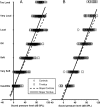The auditory sensitivity is increased in tinnitus ears
- PMID: 23392665
- PMCID: PMC6619157
- DOI: 10.1523/JNEUROSCI.3461-12.2013
The auditory sensitivity is increased in tinnitus ears
Abstract
Increased auditory sensitivity, also called hyperacusis, is a pervasive complaint of people with tinnitus. The high prevalence of hyperacusis in tinnitus subjects suggests that both symptoms have a common origin. It has been suggested that they may result from a maladjusted increase of central gain attributable to sensory deafferentation. More specifically, tinnitus and hyperacusis could result from an increase of spontaneous and stimulus-induced activity, respectively. One prediction of this hypothesis is that auditory sensitivity should be increased in tinnitus compared with non-tinnitus subjects. The purpose of this study was to test this prediction by examining the loudness functions in tinnitus ears (n = 124) compared with non-tinnitus human ears (n = 106). Because tinnitus is often accompanied by hearing loss and that hearing loss makes it difficult to disentangle hypersensitivity (hyperacusis) to loudness recruitment, tinnitus and non-tinnitus ears were carefully matched for hearing loss. Our results show that auditory sensitivity is enhanced in tinnitus subjects compared with non-tinnitus subjects, including subjects with normal audiograms. We interpreted these findings as compatible with a maladaptive central gain in tinnitus.
Figures






References
-
- Allen JB, Hall JL, Jeng PS. Loudness growth in 1/2-octave bands (LGOB)—a procedure for the assessment of loudness. J Acoust Soc Am. 1990;88:745–753. - PubMed
-
- Chrostowski M, Yang L, Wilson HR, Bruce IC, Becker S. Can homeostatic plasticity in deafferented primary auditory cortex lead to travelling waves of excitation? J Comput Neurosci. 2011;30:279–299. - PubMed
-
- Clark JG. Uses and abuses of hearing loss classification. ASHA. 1981;23:493–500. - PubMed
Publication types
MeSH terms
LinkOut - more resources
Full Text Sources
Other Literature Sources
Medical
